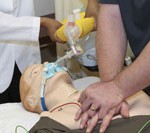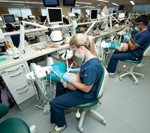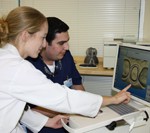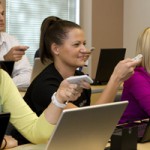Get ready, get tech, go!
Posted: June 21, 2013
Healthcare is spurred by the latest and greatest advances in technology. Instead of a manila folder and pen in hand, doctors use iPads to update patients’ electronic medical records. Dentists help perform a root canal on a special needs patient from a thousand miles away via video telecommunications systems. Physical therapists use social media to keep patients informed and market their clinics.
At ATSU, countless tech tools are available to promote learning. With educational technology rapidly evolving, Still Magazine wondered which products and what software were making the biggest difference for students. After beta testing and analyzing the data, here are ATSU’s top five ed-tech tools as named by Still Magazine.
No. 5-Google+: Social butterflies
Many schools use Facebook and Twitter to connect with and attract prospective students for admission. These platforms are less often used to engage current students, but it seemed like a no-brainer for SHM to create an online social community.
“There’s a safer environment to share; it’s not so anonymous anymore because they know who they’re in class with, and they’re able to connect better and share more.” – Katherine M. Adler, DHA, FACHE, associate dean for academic success and assessment, SHM
“We wanted to create our own virtual campus because we are online and don’t have a campus people identify with,” says Katherine M. Adler, DHA, FACHE, on the strategy behind the School’s social media initiative. “We wanted to figure out a way to make our students feel like a part of more than just coming to class.”
SHM wanted to get to know its students better and connect them with faculty and alumni outside the classroom to build strong, lasting relationships. SHM primarily uses Google+, a social network of sorts, to start conversations. Here, admins at SHM promote special programs such as “Rockstar Fridays”—a weekly nomination and public acknowledgement forum for the entire University community.
Dr. Adler, who is SHM’s associate dean for academic success and assessment, feels that Google+ is helping students learn on a deeper level.
“I have noticed it’s easier for students to put a name with a face, so faculty and the student body become people. There’s a safer environment to share; it’s not so anonymous anymore because they know who they’re in class with, and they’re able to connect better and share more.”
Coming soon, SHM will add a text messaging component to their efforts. Students will receive quick reminders regarding class schedules and financial aid deadlines.
Still in its infancy, SHM sees huge potential with social media.
“The world is not as big as it used to be; it’s much easier to connect,” Dr. Adler says.
No. 4-Human patient simulators: Rise of the machines

Students work with a SimMan® patient in the PA program.
Human patient simulators are ideal for gaining next-to-real life experience without the possibility of endangering patients. Thus, they are a standard in labs in the DO, dental, PA, and PT programs.
By the end of a KCOM student’s second year they will have spent nearly 20 hours in the Daraban Patient Simulation Center, completing courses such as advanced cardiac life support and practicing skills such as intubation on the Laerdal SimMan® and SimMan® 3G.
“Gaumard Noelle® allows learners to participate in several delivery scenarios such as normal birth, breech delivery, shoulder dystocia, and C-section. Simbionix GI Mentor™ allows for various colonoscopy/bronchoscopy scenarios,” explains David Patterson, MEd, director, simulation assessment, KCOM.
SimMan®, Harvey®, and SimBaby™ are similarly used at SOMA, where students work with them for 20 hours in their first year.
At ASDOH, rows of mannequin heads line the dental lab. LED screens are mounted next to KaVo dental simulation units with electric hand pieces.
“Simulated patients give students a better experience because they learn without negative consequences,” says Klud Razoky, BDS, assistant dean, ASDOH. “They practice the same kinds of procedures they would encounter in a clinic.”
Physical therapy students at ASHS train using HPSs as well. According to PT Assistant Professor John Heick, PT, DPT, OCS, the learning environment simulates that of an emergency department.

The dental lab at ASDOH houses 77 human patient simulators.
“SimMan® patients can mimic breathing problems or cardiac dysrhythmias and can be voice controlled by a PT from a separate room,” says Dr. Heick. “Patient interactions can be recorded for students to watch back with the professor to receive feedback.”
Dr. Heick says sims provide an ideal learning experience because he can comment on all aspects of the patient interaction and on students’ clinical decisions as it’s replayed.
The Physician Assistant program is taking an interprofessional approach. Nursing students from Grand Canyon University, together with PA students, are working clinical scenarios with SimMan®.
“Bringing students together from different programs allows them to get an early start on coordinating patient care as a collaborative healthcare team,” explains Ian McLeod, PA-C, ATC, assistant professor, physician assistant studies.
While the patients are simulated, the experience gained is real. Our students are no dummies: Many studies show students engaged in medical simulation training have higher test scores and greater retention rates than those receiving more traditional training.
No. 3-Virtual CAD/CAM technology: The quicker fixer

When designing a
CAD/CAM restoration,
work is magnified
in 3-D. This allows
students to critically
evaluate their work
and provides excellent
hands-on teaching
opportunities.
Using virtual CAD/CAM technology, dental students are learning efficient techniques and processes that will make a lasting impression on patients. CAD/CAM technology, short for computeraided design and computer-aided manufacturing technology, allows students to produce in-office fabricated dental restorations such as crowns, inlays, and onlays.
Conventional methods of restorations include creating an impression of the teeth, sending the impression to an off-site lab, waiting weeks to receive the restoration, and the patient returning to the clinic for it to be bonded or cemented in place. With CAD/CAM, restorations can now be completed in-house within one day.
“Ideally, students can make a restoration in one visit,” Dr. Razoky says. “They make a digital image of the tooth, virtually design the restoration, send the design to an on-site milling unit, and then bond it in place in the same visit—saving time and money.”
Since CAD/CAM is used in many clinics today, ASDOH integrated the technology into its curriculum to better prepare students for the dental field. Students use the technology beginning in their second year, during their third and fourth years on live patients with faculty supervision, and also in outreach programs such as mobile clinics.
“While some people pay for special courses with this technology, we have it integrated into our curriculum,” says Dr. Razoky. “We graduate dental students with a better understanding of current technology.”
No. 2-Medical gaming: Game on
Students may have short attention spans, but a range of medical gaming options at ATSU has even the most passive students actively participating in the classroom. A 2010 study by BMC Medical Education found 96 percent of medical students polled felt education should make better use of new media technologies. Consistent efforts are being made to integrate gaming into curricula, including the use of audience response systems, apps for smartphones and tablets, virtual patient simulation, and customizable game boards.
An audience response system is a combination of handheld remote devices (clickers), receivers, and software that allows students to send their responses to classroom activities to a computer. Depending on the application, students can respond individually or in teams with multiple choice, true/false, yes/no, and short essay answers. Responses are shared immediately.

Kristen Gacka, PA, ’14, takes the clicker
competition seriously.
“Decades of data suggest students who engage interactively learn concepts better, retain them longer, and can transfer information to other settings more effectively than passive learners,” says Robin Pettit, PhD, professor, SOMA.
Dr. Pettit uses ARS for PowerPoint presentations and computer game shows. She intersperses presentations with clicker interaction every 7-10 minutes, often in a competition format. This includes icebreakers, funny “wake up” slides with material-related questions, image challenge slides, opinion polls, and practice quizzes. She believes this interaction focuses students’ attention, connects previous and new knowledge, and motivates learning.
Dr. Pettit says, “The quick feedback obtained with ARS provides information that can be used by both the instructor and the student; for example, it may demonstrate gaps in knowledge the instructor can immediately address.”
ARS has also proved beneficial to the PA program. Assistant Professor Monica Fernandez, MMS, PA-C, has been using clicker questions and electronic games in both her pharmacology and medical Spanish courses for nearly three years.
“Not only do they help me gauge the class’ understanding of the material, but they also tend to be one of the students’ favorite aspects of the lectures,” Fernandez says.
“I love clicker questions,” says Kristen Gacka, first-year PA student. “It makes learning the material fun and motivates me to study more often.”
“We are using technology not only to be more efficient and effective, but also to engage students,” says PA Program Chair Albert Simon, DHSc, PA-C. “Technology can be a powerful facilitator in assisting students to have a greater role in their own learning.”
Apps for handhelds are another innovative gaming tool. SOMA and Medical Joyworks are evolving its No. 1 medical app Prognosis to align with SOMA’s unique clinical presentation model. The renovated app is nearing completion and will be implemented in third- and fourth-year curriculum.
Using Prognosis, students will be presented with simulated patient encounters and asked to evaluate and treat the patient. Students must correctly order labs, interpret diagnostics, and evaluate physical findings to receive more information and a reward token. If they enter incorrect information, the game informs them of their error, provides background information, and allows them to make different choices. Students continue with the clinical presentation until correct answers are entered.
Another gaming platform is virtual patient simulation. Complex clinical presentation schemes help students develop higherlevel decision-making and reasoning skills. Using DecisionSim at SOMA, first-year students are honing these important skills and can safely practice the application of clinical knowledge.
“Even wrong answers become teaching moments,” says Noel Carrasco, MD, professor.
Dr. Carrasco is part of a large team of educators at SOMA who are developing games as learning tools, which also includes customizable game boards and TV show spin-offs. Using products like Bravo! by C3 SoftWorks, professors design interactive games that directly correlate to curriculum.
No. 1-iPads: Goodbye, paper trail

KCOM’s class of 2016 is the first to use Universityprovided
iPads for coursework.
KCOM students Kevin Sagers, Talon Anderson, Dan Hilton, and Micheal McGrew were jaded by inefficiencies in the classroom: wasted paper, high costs associated with printing handouts, and squandered study time searching through notes. Knowing students had a better option, the group did their homework and found iPads could have a dramatic impact on students and the University.
Thanks to their grassroots effort and a pilot project conducted the previous year, all first-year students received new iPads to use in their coursework this past fall. Strongly supported by ITS and administration, the iPad initiative provides many benefits to students, who report feeling more organized and say studying is more convenient. Plus, iPads are reducing printing costs and ATSU’s carbon footprint.
KCOM is joining the likes of Stanford, Harvard, Brown, Ohio State, and University of California, Irvine—prestigious universities also providing iPads for coursework.
“They are in the same phases we are as to rolling these out,” says Hilton, a third-year student and anatomy fellow. “It’s been eye-opening and refreshing to see KCOM on the leading edge of this movement.”
Smaller and lighter than a traditional laptop, iPads are also more functional. With a longer battery life, students use them all day without stopping to recharge. And, the variety of apps allow for greater efficiency and accessibility.
“Using note-taking devices, students can annotate, highlight, and embed YouTube videos right next to their notes,” says Hilton. “It’s almost like 3-D versus 2-D learning.”
Perhaps the greatest long-term benefit is preparing students to become physicians of the future. As technology and medicine become more integrated, many physicians are now taking iPads to patients’ bedsides where they can pull up electronic medical records, X-rays, and charts; explain procedures and symptoms to patients; and complete charts before leaving the room.
“Students will be able to go into hospitals and serve patients better because they have an understanding of the technology that’s being used and how to use it for the benefit of the patient,” says Anderson, a biomed student.
Students aren’t the only ones going paperless. iPads are also clicking with professors. “iPads allow for a potentially deeper collaboration between professors and students,” says Sagers, OMS II. “The possibilities are endless.”
The ease of sharing materials allows professors to read through a research paper or presentation, highlight key points, make annotations, and send it to the class with just two clicks.
Professors are also using iLectures to record their screen and voice as they go through a lecture, highlight, and point to pictures. The iLecture is uploaded to Blackboard Mobile Learn for students to access with their iPads.
As for the price tag, students won’t fall off the fiscal cliff. Equipment costs were reworked to include the cost of the iPads, so students pay no additional fees. The University won’t be taking a dive either, as the iPad implementation is expected to create a cost savings of approximately $80,000-$100,000 per graduating class.
Working smarter, not harder
As technology and healthcare education continue to intertwine, it can be a challenge to recognize what products and software to which students at ATSU should be exposed.
“All technology has a niche. There is no one thing that is the end-all, be-all. The challenge can be getting all these technologies to work together.” – Bryan Krusniak, BSE, MBA, ITS assistant vice president
“All technology has a niche. There is no one thing that is the end-all, be-all,” says Information Technology & Services Assistant Vice President Bryan Krusniak, BSE, MBA.
It can also be a challenge to balance the use of technology with human interaction, which is vital to healthcare delivery and was the basis on which ATSU was founded. In a time when even a phone call seems overburdened in company with text messaging and email, it’s easy to fall victim to the mindset that less face time is better time management.
Nonetheless, a wise use of technology in the classroom, like those in our top five list, leads to a well-prepared generation of healthcare providers who work smarter, not harder.
Now that’s something to tech about.